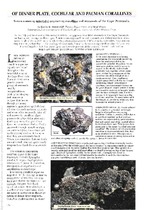| dc.contributor.author | Maneveldt, Gavin | |
| dc.contributor.author | Frans, Rene | |
| dc.date.accessioned | 2014-02-11T11:57:55Z | |
| dc.date.available | 2014-02-11T11:57:55Z | |
| dc.date.issued | 2001 | |
| dc.identifier.citation | Maneveldt, G.W. & Frans, R. (2001). Of dinner plate, cochlear and pacman corallines: seven common intertidal encrusting red seaweeds of the Cape Peninsula. Veld & Flora, 87(3): 134-135 | en_US |
| dc.identifier.issn | 0042-3203 | |
| dc.identifier.uri | http://hdl.handle.net/10566/1003 | |
| dc.description.abstract | In the fifth and final part of this series of articles on common intertidal seaweeds of the Cape Peninsula, we look at encrusting coralline algae. These encrusting coralline and red seaweeds are widespread in shallow waters in all the world’s oceans, where they often cover close to 100% of rocky substrates. Nowhere are they more important than in the ecology of coral reefs. Not only do encrusting coralline algae help cement the reef together, but they make up a considerable portion of the mass of the reef itself and are important primary products and food for certain herbivores. | en_US |
| dc.language.iso | en | en_US |
| dc.publisher | Botanical Society of South Africa | en_US |
| dc.rights | Copyright Botanical Society of South Africa. Permission has been given to reproduce this file in the Repository. | |
| dc.subject | Cape Peninsula | en_US |
| dc.subject | Encrusting coralline algae | en_US |
| dc.subject | Herbivores | en_US |
| dc.subject | Red seaweeds | en_US |
| dc.subject | Rocky substrates | en_US |
| dc.title | Of dinner plate, cochlear and pacman corallines: seven common intertidal encrusting red seaweeds of the Cape Peninsula | en_US |
| dc.type | Article | en_US |
| dc.privacy.showsubmitter | false | |
| dc.status.ispeerreviewed | false | |

